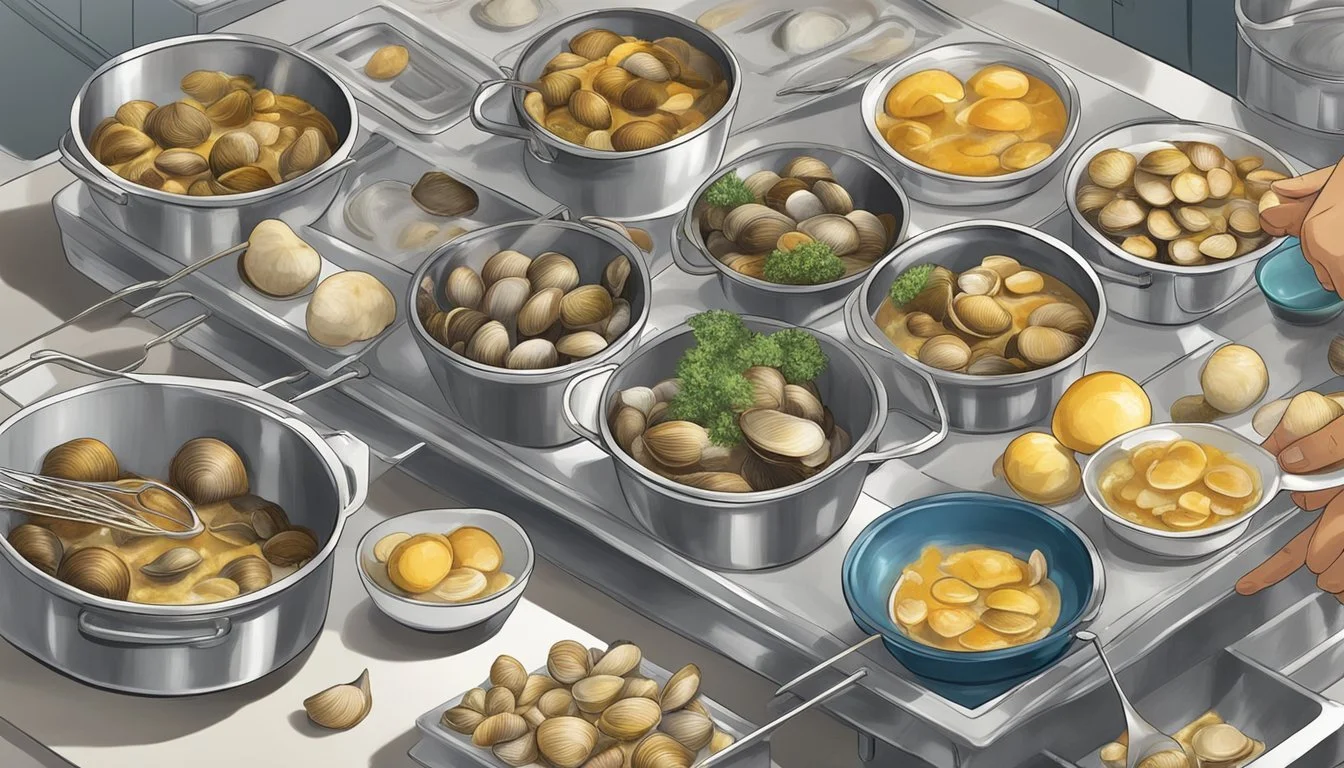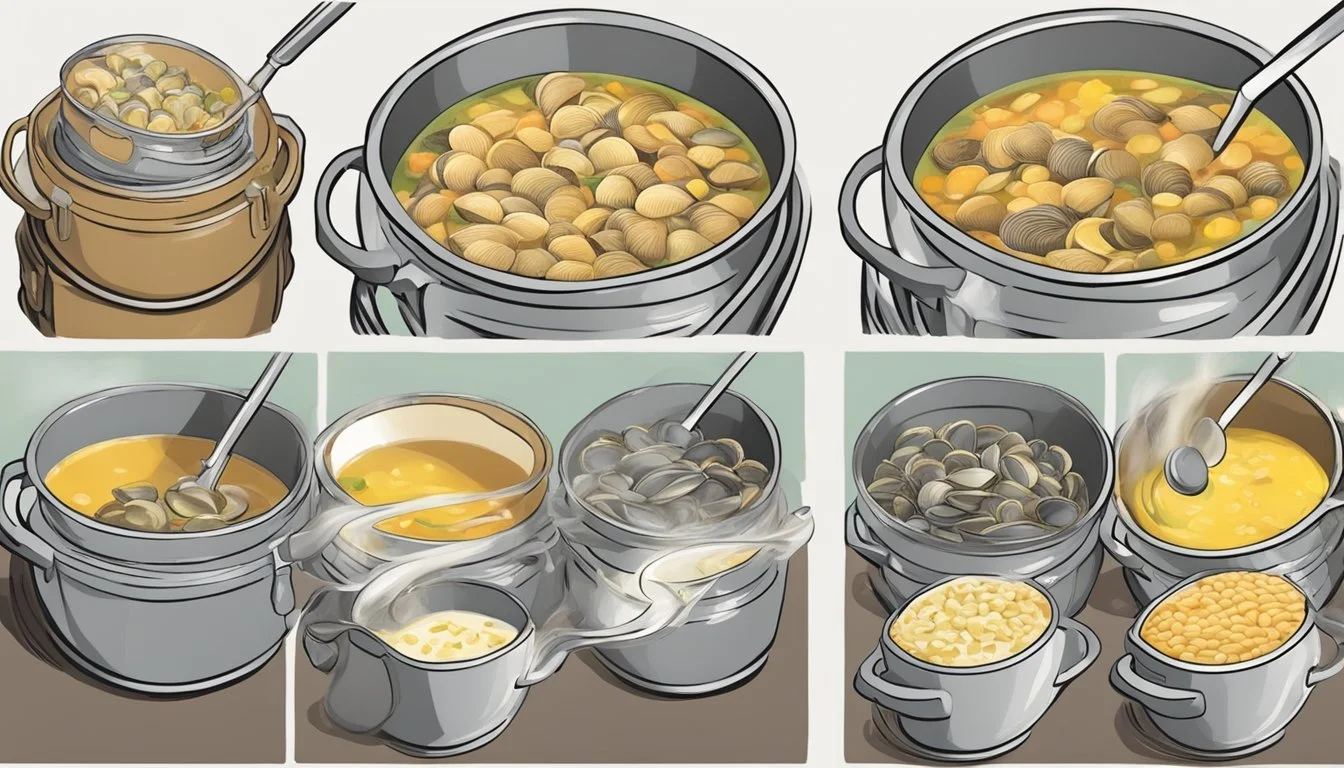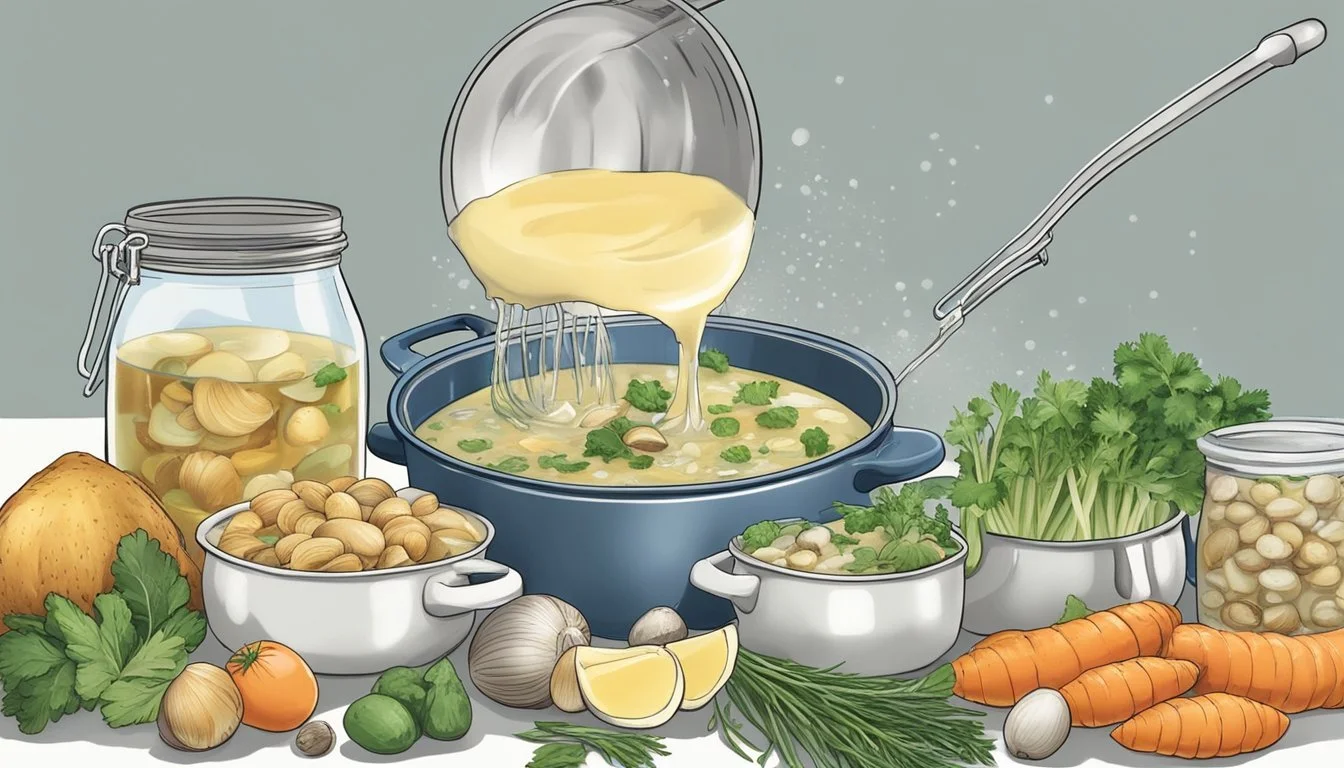Fixing Overly Salty Canned Clams
Effective Techniques for Perfect Chowder Flavor Balance
Canned clams (What wine goes well with clams?) are a convenient ingredient for seafood (What wine goes well with seafood?) aficionados, offering the rich taste of clams without the need for extensive preparation. However, their preservation process often leaves them with a high sodium content, which can lead to an overly salty flavor when added to dishes. From chowders to stews, these pantry staples can contradict the flavor balance sought in carefully crafted recipes. Understanding how to fix this issue is essential for maintaining both the savory essence of the seafood and the nutritional considerations of the meal.
Clever culinary techniques can rectify the saltiness without diminishing the clams' contribution to a dish. Rinsing canned clams helps to wash away excess brine and any impurities, like sand, which can linger from the canning process. In addition to rinsing, home cooks can employ other strategies to counterbalance saltiness, such as the addition of acidic components or aromatic herbs, which can enhance the overall flavor profile of the food. These methods ensure that clams enrich the dish with their natural taste, complementing other ingredients rather than overwhelming them.
For those on a budget, canned clams present a cost-effective way to enjoy seafood, and fixing the issue of saltiness makes them a versatile component in a variety of recipes. By mastering the balance of flavors, canned clams can easily transform into a nutritionally sound and delicious element of numerous dishes, affirming their place as a valuable, flavorful, and budget-friendly item in everyday cooking.
Understanding Salt and Flavor Balance
Salt is a critical ingredient in cooking that enhances other flavors within a dish. When used appropriately, salt can elevate the taste profile of ingredients, making them more pronounced and enjoyable. However, saltiness can dominate and throw off the delicate flavor balance when it's excessive, particularly in canned clams, which often contain added salt as a preservative.
When incorporating canned clams into chowders, a cook should consider the preexisting salt content. The goal is to achieve a harmonious balance where salt complements rather than overshadows the ingredients. Here are ways to manage salt levels:
Rinse canned clams under cold water to remove surface salt.
Balance overly salty flavors by introducing elements of the five basic tastes:
Sweetness, with a pinch of sugar or a dash of cream.
Sourness, via a squeeze of lemon juice or a splash of vinegar.
Bitterness, through the addition of leafy greens or a touch of bitter herbs.
Umami, with a small amount of tomato paste or mushrooms for depth without added salt.
It's about finding the right interactions among ingredients to ensure the final dish is flavorful without being too salty. Regular tasting and small adjustments during the cooking process aid in hitting the perfect note of savory flavor that one expects in a chowder. Remember that it's far easier to add more salt to a dish than to try to mitigate an excess. Therefore, chefs should add salt incrementally and taste often.
The Science of Rinsing Canned Clams
Rinsing canned clams can influence the saltiness and overall flavor profile of your chowders. This section provides an in-depth look at effective rinsing methods and compares the differences between rinsing and soaking.
Effectiveness of Rinsing Techniques
Rinsing canned clams is a common practice aimed at reducing the salt content in the natural juices that preserve the clams. One effective method involves placing the clams under cool tap water and gently agitating them to ensure that any excess saltiness and potential sediments are washed away.
Steps for Rinsing Canned Clams:
Open the can and drain the natural juices.
Place clams in a colander.
Run cool tap water over the clams for 30-60 seconds.
Allow clams to drain.
This method is quick, straightforward, and helps maintain the integrity of the clams before they are added to the dish.
Rinsing vs. Soaking in Fresh Water
Rinsing is a swift method compared to soaking, which involves submerging canned clams in a bowl of fresh water for an extended period. While rinsing removes surface salt, soaking allows for a more thorough desalination process.
Rinsing:
Short duration.
Decreases immediate surface salinity.
Soaking:
Long duration (often several minutes).
Potentially more effective for deeply embedded salt.
However, soaking might also lead to a loss of flavor as the clams could also release some of their intrinsic, delicate brininess into the soaking water. Chefs must therefore decide based on the desired flavor intensity in their chowder.
Alternative Methods to Reduce Salinity
Reducing the saltiness of canned clams involves creative culinary techniques beyond just rinsing. This section explores methods utilizing ice and balancing flavors with complementary ingredients as practical solutions.
Use of Ice to Dilute Salt Content
When preparing a chowder with overly salty canned clams, one can introduce ice as a strategic ingredient. The introduction of ice into the simmering chowder not only cools the dish slightly but also, as it melts, the additional water helps to distribute and dilute the excess saltiness. It's crucial to use ice made from filtered or distilled water to avoid introducing new flavors or contaminants.
Balancing with Other Ingredients
To counteract the saltiness in canned clams, incorporating other ingredients into the chowder is an effective approach. Butter and olive oil, which carry rich flavors, can create a fuller taste profile, detracting from the excess saltiness. Here is a breakdown of complementary ingredients:
Dairy: A dash of cream or milk can mellow out the salty flavor.
Acid: A squeeze of lemon or a splash of vinegar adds brightness and contrasts the saline taste.
Sweetness: Incorporating a sweet element such as carrots or sweet corn can offer a balancing sweetness.
Fats: Rich fats from butter or olive oil coat the mouth and can soften the perception of salt.
By carefully selecting and adding these ingredients, one can effectively rebalance the flavors in a chowder, diminishing the prominence of salt without losing the essence of the dish.
Selecting and Cooking with Different Clam Types
In preparing clam dishes, one must consider the type of clams used, as they influence the protein content and texture of the dish. Selecting the appropriate clam variety and understanding their cooking properties can make a significant difference.
Comparing Canned, Fresh, and Baby Clams
Canned clams are a convenient and year-round option for recipes. They typically come minced, chopped, or as whole baby clams. Fresh clams offer a firmer texture and brighter, oceanic flavor. They require more preparation, involving thorough cleaning and shucking. Baby clams, whether canned or fresh, are tender and mild, making them ideal for delicate dishes or as a subtle protein addition.
Canned Clams: Pre-cooked and packed with their juice; ideal for time-saving.
Fresh Clams: Require purging sand, usually more flavorful, better for elegant dishes.
Baby Clams: Smaller, tender, and with a milder taste; versatile in various recipes.
Protein Quality in Various Clam Types
The protein quality in clams depends on their type and freshness. Fresh clams generally offer a higher nutritional profile, including a rich source of protein. One must cook them cautiously to prevent them from becoming too tough.
Fresh Clams: High-quality protein that can become rubbery if overcooked.
Canned Clams: Convenient, though they may lose some texture and flavor due to the preservation process.
Baby Clams: Less protein per volume due to their size but perfectly tender when cooked correctly.
In chowders, using a combination of canned and fresh clams can balance flavor and texture while providing a satisfying protein component.
Preparing Clams for Specific Dishes
Preparing canned clams for inclusion in various dishes requires an understanding of the dish's flavor profile and the role that the clams will play within it. Different preparations are suitable for specific types of dishes, ranging from hearty chowders to light salads.
Integration into Chowders and Stews
In preparing clams for chowders and stews, it is essential to balance the clam's salinity with the other ingredients. For a Manhattan-style chowder, where tomatoes add acidity, one might choose to add the clams without additional rinsing, letting the salty brine complement the natural sweetness of the tomatoes. Conversely, a New England clam chowder, famous for its creamy base, might require rinsed clams to prevent the dish from becoming overly salty. Consistency is key, so one should ensure the clams are chopped to a uniform size before adding to the pot.
Enhancing Pasta and Salads with Clams
Canned clams can dramatically elevate a simple pasta dish or a salad. For linguine with clam sauce, clams are typically sautéed with garlic, a touch of white wine, and sometimes a hint of lemon, which is best done after a brief rinse to control saltiness. Clam sauce can be made more robust with the addition of parsley and red pepper flakes. When adding clams to a salad, rinsing is recommended to avoid overpowering the other fresh ingredients. The clams can be tossed with dressing and served over greens, adding a layer of briny flavor and protein.
Creating Flavorful Seafood Combos
Canned clams complement a variety of seafood recipes, working well when combined with other seafood in a stew or mixed dish. A seafood stew might include a medley of clams, mussels, (What wine goes well with mussels?) and fish, so the clams should be rinsed to prevent the brine from overwhelming the delicate flavors of the other seafood. To create harmonious seafood combos, it's important to consider cooking times; clams can be added last to recipes to ensure they are warmed through yet not overcooked.
Storing and Preserving Clams
Proper storage of clams ensures not only their freshness but also their safety for consumption. Refrigeration and pantry storage have different requirements and results in terms of longevity and quality of clams and clam juice.
Optimal Conditions for Refrigerated Clams
To maximize freshness, one should store live clams in the refrigerator. They retain their quality best when placed in a breathable bag, positioned in the back of the refrigerator where the temperature is coldest and more stable. The bag prevents the accumulation of moisture while allowing some air flow. Consumers are advised to layer a damp cloth or paper towel over a bowl of clams, playing a dual role in maintaining moisture while preventing the clams from becoming waterlogged.
Refrigerator Storage Checklist:
Keep in breathable bag or bowl covered with a damp cloth
Place in the back of the fridge
Aim for prompt cooking and consumption
Longevity and Quality Control in the Pantry
Clam juice and canned clams, when unopened, can be stored in the pantry. In this environment, preservatives within canned clams help extend the shelf life. The pantry should be cool and dry to prevent the compromise of the can's integrity due to temperature fluctuations or moisture. Once opened, clam juice or canned clams should be immediately refrigerated to prevent spoilage and to maintain flavor.
Pantry Storage Guidelines:
Store unopened canned clams in a cool, dry place
Monitor expiration dates for quality control
Refrigerate after opening
Culinary Tips and Tricks
When preparing dishes with canned clams, chefs must strive to balance flavors and ensure cleanliness to achieve a culinary delight without the overwhelming saltiness that can sometimes accompany canned seafood.
Utilizing Clam Juice and Natural Juices
Clam juice, the liquid found within the can of clams, is packed with flavor that can enhance the overall taste of chowders and stews. To mitigate saltiness:
Reduce: If clam juice is too salty, chefs may choose to reduce its volume by simmering, concentrating the flavor while allowing some sodium to dissipate.
Dilute: Conversely, mixing clam juice with unsalted liquids such as water, broth, or cream can dilute excess saltiness while preserving the clams' essence.
Substituting a portion of the clam juice with natural juices, such as vegetable stock or milk, can balance the flavor profile, making the dish more palatable. Clam juice should be tasted and evaluated before adding it to dishes, as brands may vary in salt content.
Dealing with Shells, Sand, and Smell
Canned clams should be free of shells; however, it is always wise to inspect and clean them to ensure the final dish is free of any unwanted grit.
Rinse Procedure: For clams that may have residual sand, rinsing in a colander under cold running water can help remove sand particles.
Sniff Test: Freshness can be assessed by smell—an overly fishy or off-putting odor can indicate spoilage, so one should ensure that the canned clams have a clean, ocean-like scent.
Sand can compromise the texture of a dish; therefore, a thorough inspection for sand and shells is crucial. If sand is a concern, clams can be briefly soaked in a bowl of water to help any remaining sand naturally settle to the bottom. The clams can then be gently removed, leaving sand behind. Chefs should also be attentive to the smell of the clams, as a clean smell is indicative of a quality product and will result in a more appetizing chowder or stew.
Recognizing and Choosing Quality Canned Clams
When choosing canned clams, consumers should look for brands with a solid reputation for seafood products. High-quality canned clams typically list clams, salted water, and sometimes added seasonings like garlic in their ingredients without artificial flavors.
Ingredients to Consider:
Clams: Should be the first ingredient, indicating a higher clam content.
Water: Often used as the preserving liquid; salted or unsalted options vary by brand.
Added Salt: Check the sodium content if you're watching your salt intake.
Seasonings: Some brands include garlic or herbs for extra flavor.
Shelf Check:
Examine the can for any signs of damage or bulging.
Check the expiration date to ensure freshness.
Canned Clams Varieties:
Chopped Clams: Ideal for recipes like chowders or dips where consistency matters.
Whole Clams: Better suited for dishes where the clam is the centerpiece.
When shopping at the supermarket, note the origin of the clams as it can influence taste and quality.
Popular Brands:
Bumble Bee: Known for their baby whole clams.
Foods Guy: Often recommended for cooking use.
Before purchasing, ensure that the canned clams have clear labelling and offer information about the harvest location and packaging process. Quality canned clams provide convenience without compromising on the seafood's natural flavor and texture.
Health and Nutritional Aspects of Clams
Canned clams offer a plethora of nutrients essential for good health, but their sodium content must be managed within a balanced diet.
Sodium Content and Dietary Considerations
When consuming canned seafood, particularly canned clams, consumers should be vigilant about the sodium content. Canned clams can be high in sodium, which is necessary for preserving the product. Excess sodium intake may lead to health issues such as hypertension. It's prudent to examine the nutritional label for sodium content and consider rinsing the clams to reduce this content.
Typical Sodium Range in Canned Clams:
Low Sodium Options: 50-200 mg per serving
Regular Options: 300-800 mg per serving
Beneficial Nutrients Found in Clams
Canned clams are a nutritious option rich in several essential nutrients. They are particularly known for their high protein density, offering significant protein content relative to their calorie count. Moreover, clams are an excellent source of vitamin B12, iron, and zinc; their vitamin B12 content exceeds 100 percent of the daily value in a single serving.
Key Nutrients in Clams (per 100g):
Protein: Approximately 12.8 grams
Vitamin B12: Over 100% of Daily Value
Vitamin C: Significant contributor to daily requirements
Iron & Zinc: Essential minerals for various bodily functions
Overall, clams present numerous nutritional advantages but require mindful preparation due to their sodium content.
Innovative Clam Dishes to Try at Home
In the quest for culinary creativity, clams offer a versatile foundation for a variety of innovative dishes. Chefs and home cooks alike can explore the depth of flavor that clams provide through inventive dips, sauces, and international dishes.
Experiments with Clam Dip and Sauces
The classic clam dip can be transformed by incorporating fresh herbs or cream cheese for a richer texture and more complex flavor profile. For a more robust creation, one might blend minced clams, a touch of garlic, softened cream cheese, lemon zest, and a sprinkle of smoked paprika. Serving it chilled allows the flavors to meld together, creating a refreshing appetizer.
In the realm of clam sauces, the inclusion of fresh ingredients can elevate a simple pasta dish. A sauce might combine chopped clams, a dash of white wine, fresh parsley, and a hint of chili flakes for heat. By simmering these ingredients, the sauce thickens and clings to the pasta, infusing it with the subtle brininess of the clams and the nuanced flavors of its accompanying seasonings.
Incorporating Clams into International Cuisine
Clams are a staple in numerous international dishes, and incorporating them into recipes like Spanish paella introduces a unique seafood dimension. In paella, clams contribute both texture and a distinct oceanic flavor that harmonizes with the saffron-infused rice, vegetables, and often, other seafood and meats. To achieve a harmonious dish, it's crucial to add the clams towards the end of the cooking process, allowing them to steam open and infuse the paella with their juices.
Another way to integrate clams into international cuisine is by preparing a clam-centric version of familiar favorites. For instance, a clam-based twist on the classic Italian puttanesca sauce can provide a surprising and delightful alternative. This innovative take might include chopped clams, capers, (What wine goes well with capers?) anchovies, (What wine goes well with anchovies?) olives, and tomatoes, creating a dish that balances the savory depth of the sea with the piquancy of its accompanying ingredients.









